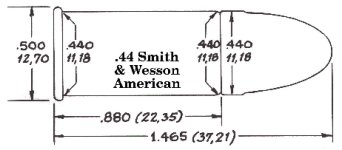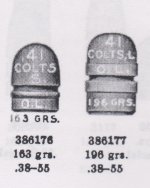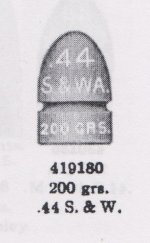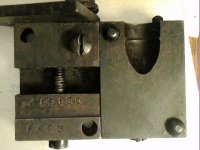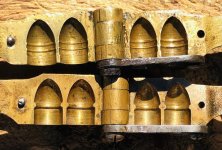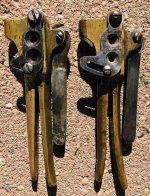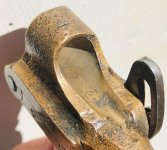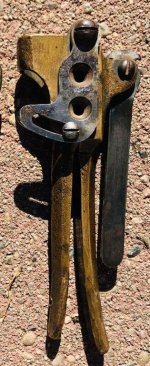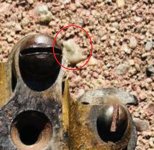- Joined
- Dec 1, 2022
- Messages
- 701
- Reaction score
- 1,136
Hi There,
I am confused on certain aspects about bullet moulds for early
cartridges like the S&W American. Several sources list the
original "American" having a bullet and case of .438" to .440"
diameter.
Now, I have seen moulds for "heeled" bullets that are designed
with a base that is of reduced diameter that fits into the cartridge
case (like the Ideal moulds 386176 & 386177). Some diagrams
of the S&W American show that the original must of been of a
heeled bullet design (see pic).
But the Ideal 419180 mould isn't of a heeled bullet design. This
begs the question, "what is the barrel dimensions of the #3
American model?" I have read that the #3 American and
Russian models used the same barrel and the 44 Russian
used a barrel with a groove diameter of .429" (or at least
later versions have these dimensions).
Now, those of us that have used Ideal and later Lyman bullet
moulds, know the first three numbers generally refer to the
diameter of the bullet the mould casts (with some leeway given
that different lead-tin-antimony alloy mixtures will give different
results from the same mould). But this "leeway" is usually
only a couple of thousandths.
Bearing this information in mind, the 419180 mould would cast
a bullet in the .417" to .421" range before sizing. These would
be too small for a barrel with a .429" groove diameter. In fact,
they shouldn't be very accurate and a lot of gas would pass by
the bullet when fired.
In fact, this bullet would be suited to a barrel with a smaller groove
diameter. So, what was the groove diameter of the original American
model? Why isn't this bullet mould of the heeled bullet design?
Can someone explain this?
Cheers!
Webb
I am confused on certain aspects about bullet moulds for early
cartridges like the S&W American. Several sources list the
original "American" having a bullet and case of .438" to .440"
diameter.
Now, I have seen moulds for "heeled" bullets that are designed
with a base that is of reduced diameter that fits into the cartridge
case (like the Ideal moulds 386176 & 386177). Some diagrams
of the S&W American show that the original must of been of a
heeled bullet design (see pic).
But the Ideal 419180 mould isn't of a heeled bullet design. This
begs the question, "what is the barrel dimensions of the #3
American model?" I have read that the #3 American and
Russian models used the same barrel and the 44 Russian
used a barrel with a groove diameter of .429" (or at least
later versions have these dimensions).
Now, those of us that have used Ideal and later Lyman bullet
moulds, know the first three numbers generally refer to the
diameter of the bullet the mould casts (with some leeway given
that different lead-tin-antimony alloy mixtures will give different
results from the same mould). But this "leeway" is usually
only a couple of thousandths.
Bearing this information in mind, the 419180 mould would cast
a bullet in the .417" to .421" range before sizing. These would
be too small for a barrel with a .429" groove diameter. In fact,
they shouldn't be very accurate and a lot of gas would pass by
the bullet when fired.
In fact, this bullet would be suited to a barrel with a smaller groove
diameter. So, what was the groove diameter of the original American
model? Why isn't this bullet mould of the heeled bullet design?
Can someone explain this?
Cheers!
Webb

